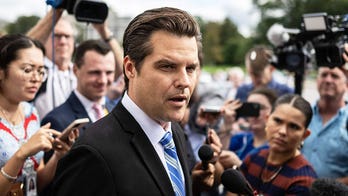Amtrak crash probe finds no mechanical trouble
Top official points to 'human factor' after release of preliminary report on deadly derailment
Federal investigators said Tuesday they've so far found no mechanical problems with the train systems at the site of last month's deadly Amtrak derailment outside Philadelphia -- leaving one top official pointing to the "human factor."
The National Transportation Safety Board released what it called "preliminary" findings in a brief report Tuesday morning, as officials also provided an update to Congress during a House committee hearing.
The report said "investigators have examined the train braking systems, signals, and track geometry" and so far, "no anomalies have been noted."
During the House Transportation Committee hearing, Federal Railroad Administration head Sarah Feinberg stressed that a cause has not officially been determined for the May 12 crash that killed eight and sent more than 200 to the hospital.
But she testified that speed was a significant factor, and said that is a "human factor."
The testimony and report made clear that investigators continue to focus on why the train accelerated to 106 mph, while approaching a 50 mph zone at a curve.
The Amtrak engineer, Brandon Bostian, suffered a head injury in the accident and has told investigators he can't remember what happened. The train was equipped with a "black box" data recorder and an outward-facing camera focused on the track ahead, but neither of those devices reveals what was happening inside the cab.
The NTSB report said forensic experts are now examining the phone records for the engineer, apparently to check if he was texting or making calls right before the crash.
"Although the records appear to indicate that calls were made, text messages sent, and data used on the day of the accident, investigators have not yet made a determination if there was any phone activity during the time the train was being operated," the report said. "Investigators are in the process of correlating the time stamps in the engineer's cell phone records with multiple data sources including the locomotive event recorder, the locomotive outward facing video, recorded radio communications, and surveillance video."
The report said the NTSB is also still investigating reports of "vandals throwing rocks or other objects at passing trains around the time of the derailment."
Meanwhile, officials testifying on the Hill stressed the importance of safety technology known as Positive Train Control.
NTSB Chairman Christopher Hart said Positive Train Control -- a system that can automatically stop a train before an accident occurs -- said a "properly installed and functional Positive Train Control ... would have prevented this accident."
Through the Rail Safety Improvement Act of 2008, Congress imposed a deadline on Amtrak and freight and commuter railroads to install the technology by the end of 2015. Today, most of these railroads are not expected to even meet the deadline, which has led to a proposal to give railroads a five-to-seven-year extension.
Hart underscored that point Tuesday, saying, "We know that most railroads will not comply with this law."
Amtrak CEO Joseph Boardman testified that Amtrak is further along in installing this technology than its contemporaries and will be able to comply with the mandate. But he said Positive Train Control, at present, is only installed "at points" between Washington and New York in that corridor.
At the hearing, he said Amtrak "deeply" regrets the tragedy last month. He said "the system works" but "we have never been able to completely eliminate the risk of human error."
The Associated Press contributed to this report.





